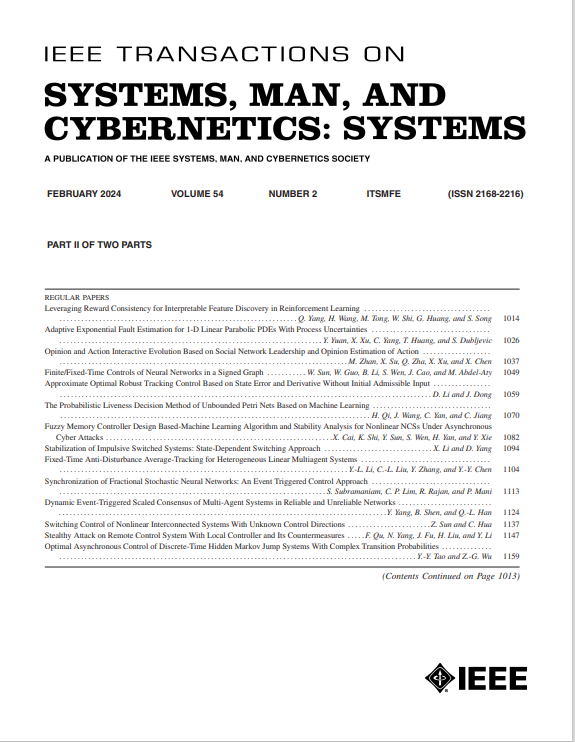Sliding-Mode-Based Output Feedback Neural Network Control for Electro-Hydraulic Actuator Subject to Unknown Dynamics and Uncertainties
IF 8.6
1区 计算机科学
Q1 AUTOMATION & CONTROL SYSTEMS
IEEE Transactions on Systems Man Cybernetics-Systems
Pub Date : 2024-09-23
DOI:10.1109/TSMC.2024.3460191
引用次数: 0
Abstract
Unstructured dynamics, un-modeled parameters, and uncertainties in electro-hydraulic servo-valve-controlled actuators (EHSAs) bring difficulty in designing controllers for output tracking performance with stability and robustness satisfactions. Therefore, this article proposes an output feedback-based control for position regulation subject to fully unknown system behavior and uncertainties. With this idea, a coordinately transformed canonical system is utilized where all mismatched/matched uncertainties are lumped into one term with unknown dynamics. Then, a radial basis function neural network (RBFNN) with a norm of weighting vector estimation combined with a time-delayed estimation (TDE) is employed to effectively compensate for the system behavior. Accordingly, a second-order sliding-mode-based output feedback control is conducted to avoid following the step-by-step backstepping control (BSC) design. Interestingly, the proposed methodology requires only the measured output for the control law implementation with only one estimated variable for the system dynamics compensation due to using the hybrid RBF-based TDE (RBF-TDE). Moreover, to lower this approximated error, a modified sliding-mode-based nonlinear disturbance observer (DOB) is extensively involved. The closed-loop system stability is mathematically proven through the Lyapunov theorem with simulation and experiment on EHSA protocols to realize the effectiveness of the proposed algorithm.基于滑动模式输出反馈神经网络的未知动态和不确定性电液推杆控制装置
电液伺服阀控执行器(EHSA)中的非结构化动态、未建模参数和不确定性给设计出满足稳定性和鲁棒性的输出跟踪性能的控制器带来了困难。因此,本文针对完全未知的系统行为和不确定性,提出了一种基于输出反馈的位置调节控制方法。根据这一思路,利用了一个协调变换的典型系统,将所有不匹配/匹配的不确定性归结为一个未知动态项。然后,利用径向基函数神经网络(RBFNN)的加权向量估计规范与延时估计(TDE)相结合,对系统行为进行有效补偿。相应地,还采用了基于二阶滑动模式的输出反馈控制,以避免采用步进式反步进控制(BSC)设计。有趣的是,由于使用了基于 RBF 的混合 TDE (RBF-TDE),建议的方法只需要测量输出就能实现控制法则,而系统动态补偿只需要一个估计变量。此外,为了降低近似误差,还广泛采用了改进的基于滑动模式的非线性扰动观测器(DOB)。通过对 EHSA 协议进行仿真和实验,利用 Lyapunov 定理从数学上证明了闭环系统的稳定性,从而实现了所提算法的有效性。
本文章由计算机程序翻译,如有差异,请以英文原文为准。
求助全文
约1分钟内获得全文
求助全文
来源期刊

IEEE Transactions on Systems Man Cybernetics-Systems
AUTOMATION & CONTROL SYSTEMS-COMPUTER SCIENCE, CYBERNETICS
CiteScore
18.50
自引率
11.50%
发文量
812
审稿时长
6 months
期刊介绍:
The IEEE Transactions on Systems, Man, and Cybernetics: Systems encompasses the fields of systems engineering, covering issue formulation, analysis, and modeling throughout the systems engineering lifecycle phases. It addresses decision-making, issue interpretation, systems management, processes, and various methods such as optimization, modeling, and simulation in the development and deployment of large systems.
 求助内容:
求助内容: 应助结果提醒方式:
应助结果提醒方式:


